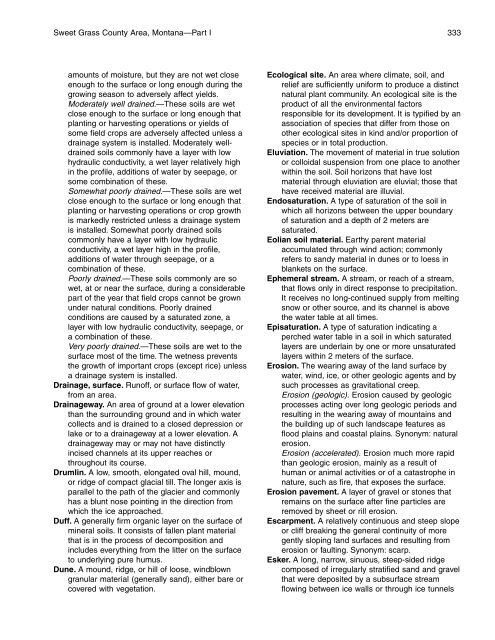Soil Survey of Sweet Grass County Area, Montana - Soil Data Mart
Soil Survey of Sweet Grass County Area, Montana - Soil Data Mart
Soil Survey of Sweet Grass County Area, Montana - Soil Data Mart
Create successful ePaper yourself
Turn your PDF publications into a flip-book with our unique Google optimized e-Paper software.
<strong>Sweet</strong> <strong>Grass</strong> <strong>County</strong> <strong>Area</strong>, <strong>Montana</strong>—Part I 333<br />
amounts <strong>of</strong> moisture, but they are not wet close<br />
enough to the surface or long enough during the<br />
growing season to adversely affect yields.<br />
Moderately well drained.—These soils are wet<br />
close enough to the surface or long enough that<br />
planting or harvesting operations or yields <strong>of</strong><br />
some field crops are adversely affected unless a<br />
drainage system is installed. Moderately welldrained<br />
soils commonly have a layer with low<br />
hydraulic conductivity, a wet layer relatively high<br />
in the pr<strong>of</strong>ile, additions <strong>of</strong> water by seepage, or<br />
some combination <strong>of</strong> these.<br />
Somewhat poorly drained.—These soils are wet<br />
close enough to the surface or long enough that<br />
planting or harvesting operations or crop growth<br />
is markedly restricted unless a drainage system<br />
is installed. Somewhat poorly drained soils<br />
commonly have a layer with low hydraulic<br />
conductivity, a wet layer high in the pr<strong>of</strong>ile,<br />
additions <strong>of</strong> water through seepage, or a<br />
combination <strong>of</strong> these.<br />
Poorly drained.—These soils commonly are so<br />
wet, at or near the surface, during a considerable<br />
part <strong>of</strong> the year that field crops cannot be grown<br />
under natural conditions. Poorly drained<br />
conditions are caused by a saturated zone, a<br />
layer with low hydraulic conductivity, seepage, or<br />
a combination <strong>of</strong> these.<br />
Very poorly drained.—These soils are wet to the<br />
surface most <strong>of</strong> the time. The wetness prevents<br />
the growth <strong>of</strong> important crops (except rice) unless<br />
a drainage system is installed.<br />
Drainage, surface. Run<strong>of</strong>f, or surface flow <strong>of</strong> water,<br />
from an area.<br />
Drainageway. An area <strong>of</strong> ground at a lower elevation<br />
than the surrounding ground and in which water<br />
collects and is drained to a closed depression or<br />
lake or to a drainageway at a lower elevation. A<br />
drainageway may or may not have distinctly<br />
incised channels at its upper reaches or<br />
throughout its course.<br />
Drumlin. A low, smooth, elongated oval hill, mound,<br />
or ridge <strong>of</strong> compact glacial till. The longer axis is<br />
parallel to the path <strong>of</strong> the glacier and commonly<br />
has a blunt nose pointing in the direction from<br />
which the ice approached.<br />
Duff. A generally firm organic layer on the surface <strong>of</strong><br />
mineral soils. It consists <strong>of</strong> fallen plant material<br />
that is in the process <strong>of</strong> decomposition and<br />
includes everything from the litter on the surface<br />
to underlying pure humus.<br />
Dune. A mound, ridge, or hill <strong>of</strong> loose, windblown<br />
granular material (generally sand), either bare or<br />
covered with vegetation.<br />
Ecological site. An area where climate, soil, and<br />
relief are sufficiently uniform to produce a distinct<br />
natural plant community. An ecological site is the<br />
product <strong>of</strong> all the environmental factors<br />
responsible for its development. It is typified by an<br />
association <strong>of</strong> species that differ from those on<br />
other ecological sites in kind and/or proportion <strong>of</strong><br />
species or in total production.<br />
Eluviation. The movement <strong>of</strong> material in true solution<br />
or colloidal suspension from one place to another<br />
within the soil. <strong>Soil</strong> horizons that have lost<br />
material through eluviation are eluvial; those that<br />
have received material are illuvial.<br />
Endosaturation. A type <strong>of</strong> saturation <strong>of</strong> the soil in<br />
which all horizons between the upper boundary<br />
<strong>of</strong> saturation and a depth <strong>of</strong> 2 meters are<br />
saturated.<br />
Eolian soil material. Earthy parent material<br />
accumulated through wind action; commonly<br />
refers to sandy material in dunes or to loess in<br />
blankets on the surface.<br />
Ephemeral stream. A stream, or reach <strong>of</strong> a stream,<br />
that flows only in direct response to precipitation.<br />
It receives no long-continued supply from melting<br />
snow or other source, and its channel is above<br />
the water table at all times.<br />
Episaturation. A type <strong>of</strong> saturation indicating a<br />
perched water table in a soil in which saturated<br />
layers are underlain by one or more unsaturated<br />
layers within 2 meters <strong>of</strong> the surface.<br />
Erosion. The wearing away <strong>of</strong> the land surface by<br />
water, wind, ice, or other geologic agents and by<br />
such processes as gravitational creep.<br />
Erosion (geologic). Erosion caused by geologic<br />
processes acting over long geologic periods and<br />
resulting in the wearing away <strong>of</strong> mountains and<br />
the building up <strong>of</strong> such landscape features as<br />
flood plains and coastal plains. Synonym: natural<br />
erosion.<br />
Erosion (accelerated). Erosion much more rapid<br />
than geologic erosion, mainly as a result <strong>of</strong><br />
human or animal activities or <strong>of</strong> a catastrophe in<br />
nature, such as fire, that exposes the surface.<br />
Erosion pavement. A layer <strong>of</strong> gravel or stones that<br />
remains on the surface after fine particles are<br />
removed by sheet or rill erosion.<br />
Escarpment. A relatively continuous and steep slope<br />
or cliff breaking the general continuity <strong>of</strong> more<br />
gently sloping land surfaces and resulting from<br />
erosion or faulting. Synonym: scarp.<br />
Esker. A long, narrow, sinuous, steep-sided ridge<br />
composed <strong>of</strong> irregularly stratified sand and gravel<br />
that were deposited by a subsurface stream<br />
flowing between ice walls or through ice tunnels
















